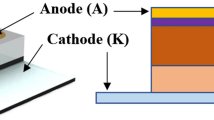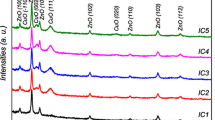Abstract
The synthesis and electrical transport features of vacuum-deposited p-ZnIn2Se4/n-CdTe (p-ZIS/n-CT) heterojunction diode (HJD) are discussed. Transmission electron microscopy (TEM) was used to characterize the microstructures of p-ZIS and n-CT thin films. The Hall measurement system determined the conductivity and carrier concentration of the ZIS and CT films; the acceptor concentration (Na) for ZIS film and donor concentration (\(N_{\rm d}\)) for CT film observed are \(4.12\times {10}^{13}\,\text{cm}^{-3}\) and \(2.80\times {10}^{14}\,\text{cm}^{-3}\), respectively. The DC electrical resistance (\(R\)) variation with temperature (T) determines thermal activation (impurity-based conduction) and bandgap energies of p-ZIS and \({n}\text{-CT}\) thin films. Scanning electron microscopy (SEM) was used to look at the surface morphology of \(p\text{-ZIS}/n{\text{-CT HJD}}\). The semiconductor characterization system (SCS-4200) was used to characterize the current–voltage (\(I{-}V\)) and capacitance–voltage (C–V) of the \(p\text{-ZIS}/n\text{-CT HJD}\) at different \(T\) (\(303{-}340\,\text{K}\)). The \(p\text{-ZIS}/n\text{-CT HJD}\)’s dark \(I{-}V\) finding shows conventional diode nature with a decent rectification ratio (RR) (\(\simeq\, 4.34\times {10}^{5}\;\text{at}\;\pm 2.0\,\text{V}\)). At a given bias, the RR value drops as \(T\) increases. The systematic assessment of \(I{-}V\) data suggests the thermionic emission (TE) mechanism at lower bias and the space charge-limited conduction (SCLC) mechanism at higher bias. The quantitative analysis estimates the barrier height (\({\varphi }_{\rm b}\)) as \(\simeq\, 0.79\,\text{eV}\) (from \(I{-}V\) measurements) and \(\simeq\, 0.88\,\text{eV}\) (from C–V measurements). Cheung’s function was utilized to derive the \({\varphi}_{\rm b}\), ideality factor (\(n\)) and the series resistance (\(R_{\rm s}\)) of the p-ZIS/n-CT HJD. With a rise in \(T\), HJD’s saturation current (\(I_{\rm s}\)), \(n\) and \({\varphi }_{\rm b}\) rise, whilst, \(R_{\rm s}\) falls. To gain insight into depletion behaviour, a study examined space charge and electric field distributions for abrupt p-ZIS/n-CT HJD. The experimental findings of Anderson’s model corroborate a theoretical energy band diagram for the p-ZIS/n-CT HJD. The p-ZIS/n-CT HJD’s photovoltaic (PV) characterization resulted in a 0.51 fill factor and 1.04% efficiency. The implications are discussed.














Similar content being viewed by others
Data availability
Data sharing does not apply to this article as no datasets were generated or analysed during the current study.
References
M. Rudan, Physics of Semiconductor Devices, 1st edn. (Springer, New York, NY, 2015), pp. 485–538
B.R. Pamplin, in CRC Handbook of Chemistry and Physics, ed. By R.C. Weast (CRC Press, Boca Raton, 1981), p. E-81
J. Filipowicz, N. Romeo, L. Tarricone, Solid State Commun. 38, 619 (1981)
S.P. Yadav, P.S. Shinde, K.Y. Rajpure, C.H. Bhosale, Sol. Energy Mater. Sol. Cells 92, 453 (2008)
S. Shionoya, Y. Tamqto, J. Phys. Soc. Jpn. 19, 1142 (1964)
S. Chander, M.S. Dhaka, Mater. Sci. Semicond. Process. 40, 708 (2015)
F.J. García, M.S. Tomar, Thin Solid Films 69, 137 (1980)
H.M. Zeyada, M.S. Aziz, A.S. Behairy, Physica B 404, 3957 (2009)
A.A. Attia, H.A.M. Ali, G.F. Salem, M.I. Ismail, F.F. Al-Harbi, Opt. Mater. (Amst.) 66, 480 (2017)
S.P. Yadav, P.S. Shinde, K.Y. Rajpure, C.H. Bhosale, J. Phys. Chem. Solids 69, 1747 (2008)
K.W. Cheng, Y.H. Cheng, M.S. Fan, Int. J. Hydrogen Energy 37, 13763 (2012)
D.K. Dhruv, B.H. Patel, Int. J. Appl. Sci. Eng. Res. 3, 121 (2014)
D.K. Dhruv, B.H. Patel, Int. J. Innov. Res. Electr. Electron. Instrum. Control Eng. 3, 9 (2015)
D.K. Dhruv, A. Nowicki, B.H. Patel, V.D. Dhamecha, Surf. Eng. 31, 556 (2015)
D.K. Dhruv, B.H. Patel, Mater. Sci. Semicond. Process. 54, 29 (2016)
D.K. Dhruv, B.H. Patel, D. Lakshminarayana, Mater. Res. Innovations 20, 285 (2016)
D.K. Dhruv, S.D. Dhruv, N. Agrawal, P.B. Patel, Mater. Today Proc. 55, 67 (2022)
K.N. Shreekanthan, K.V. Bangera, G.K. Shivakumar, M.G. Mahesha, Indian J. Pure Appl. Phys. 44, 705 (2006)
S.S. Li, Semiconductor Physical Electronics, 1st edn. (Springer, New York, 1993), pp. 287–326
S. Acharya, K.V. Bangera, G.K. Shivakumar, Appl. Nanosci. (Switzerland) 5, 1003 (2015)
C. Lamberti, G. Agostini, Characterization of Semiconductor Heterostructures and Nanostructures (Elsevier, New York, 2013)
A. Patel, P. Pataniya, G.K. Solanki, C.K. Sumesh, K.D. Patel, V.M. Pathak, Superlattices Microstruct. 130, 160 (2019)
H. Patel, K. Patel, A. Patel, H. Jagani, K.D. Patel, G.K. Solanki, V.M. Pathak, J. Electron. Mater. 50, 5217 (2021)
K.M. Al-Shibani, Physica B 322, 390 (2002)
W. Setyawan, R.M. Gaume, S. Lam, R.S. Feigelson, S. Curtarolo, ACS Comb. Sci. 13, 382 (2011)
M.M. El-Nahass, A.A. Attia, H.A.M. Ali, G.F. Salem, M.I. Ismail, Chaos Solitons Fractals 95, 52 (2017)
S.K. Cheung, N.W. Cheung, Appl. Phys. Lett. 49, 85 (1986)
C.R. Crowell, S.M. Sze, Solid State Electron. 9, 1035 (1966)
R.R. Desai, D. Lakshminarayana, R. Sachdeva, P.B. Patel, C.J. Panchal, M.S. Desai, N. Padha, J. Nano Electron. Phys. 3, 995 (2011)
M. Nasr, A.M. Mansour, I.M. El Radaf, Mater. Res. Expr. 6, 036405 (2019)
S.M. Sze, K.K. Ng, Physics of Semiconductor Devices, 3rd edn. (Wiley, New York, 2006), pp. 77–133
A. Türüt, Turk. J. Phys. 44, 302 (2021)
F. Yakuphanoglu, Physica B 388, 226 (2007)
R.D. Jones, Hybrid Circuit Design and Manufacture, 1st edn. (CRC Press, Boca Raton, 2020), pp. 62–71
Ç. Bilkan, Ş Altındal, J. Alloys Compd. 708, 464 (2017)
M. Sugiyama, T. Shimizu, D. Kawade, K. Ramya, K.T. Ramakrishna-Reddy, J. Appl. Phys. 115, 083508 (2014)
G. di Liberto, G. Pacchioni, J. Phys. Condens. Matter 33, 415002 (2021)
K.M. Gupta, N. Gupta, Advanced Semiconducting Materials and Devices, 1st edn. (Springer, Cham, 2016), pp. 87–144
K.M. Zaidan, H.F. Hussein, R.A. Talib, A.K. Hassan, Energy Procedia 6, 85 (2011)
G.M. Masters, Renewable and Efficient Electric Power Systems, 2nd edn. (Wiley-IEEE Press, Hoboken, 2004), pp. 253–315
Acknowledgements
One of the authors, S.D. Dhruv is thankful to SHODH-ScHeme of Developing High-Quality Research-MYSY (202010820029) for a scholarship.
Funding
The authors declare that no funds, grants, or other support were received during the preparation of this manuscript.
Author information
Authors and Affiliations
Contributions
All authors contributed to the study conception and design. Material preparation, data collection and analysis were performed by DKD, BHP, NA, RB, SDD, PBP and VP. The first draft of the manuscript was written by DKD and all authors commented on previous versions of the manuscript. All authors read and approved the final manuscript.
Corresponding author
Ethics declarations
Conflict of interest
The authors have no relevant financial or non-financial interests to disclose.
Additional information
Publisher's Note
Springer Nature remains neutral with regard to jurisdictional claims in published maps and institutional affiliations.
Rights and permissions
Springer Nature or its licensor holds exclusive rights to this article under a publishing agreement with the author(s) or other rightsholder(s); author self-archiving of the accepted manuscript version of this article is solely governed by the terms of such publishing agreement and applicable law.
About this article
Cite this article
Dhruv, D.K., Patel, B.H., Agrawal, N. et al. Synthesis, electrical transport mechanisms and photovoltaic characteristics of p-ZnIn2Se4/n-CdTe thin film heterojunction. J Mater Sci: Mater Electron 33, 24003–24015 (2022). https://doi.org/10.1007/s10854-022-08755-z
Received:
Accepted:
Published:
Issue Date:
DOI: https://doi.org/10.1007/s10854-022-08755-z




